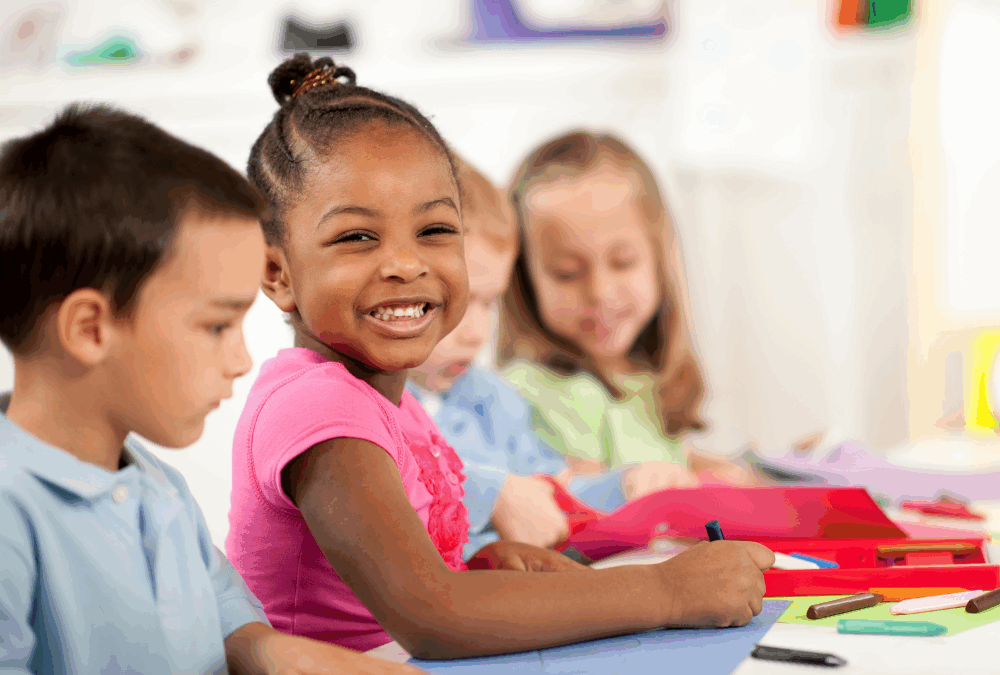How Creativity Offers a Way Back to Safety, Connection, and Self
Some pain is too big—or too early—to explain with words.
For many children, trauma doesn’t live in language. It lives in the body. In behavior. In silence.
In drawings that speak when voices can’t.
At Griffith, we work with children who have experienced the unthinkable: abuse, neglect, violence, sudden loss, displacement, or ongoing instability. For many of these children, traditional talk therapy just isn’t enough. Or it isn’t the right starting point. That’s where art and play therapy come in.
Art therapy for trauma gives children something essential: a way to express what they don’t yet have words for—and a path to healing that doesn’t require re-living the pain out loud.
Let’s talk about how art and play therapy work, what makes them so powerful for healing childhood trauma, and how these creative approaches can open doors that words can’t.
How can art therapy help with trauma?
Trauma disrupts connection—between the brain and body, between emotions and logic, and often between the child and the people who are trying to help them.
Art therapy for trauma gently restores those connections.
In a safe, structured environment, a child can use colors, shapes, textures, and movement to process what has happened. They may not say they’re afraid, confused, or grieving—but they may draw a house that’s missing a door. Or paint a sky that changes from black to red. Or build a story with figures in the sand that mirrors what they’ve lived through.
What makes art therapy so effective for trauma is that it:
- Bypasses verbal defenses. Children often don’t have the language for what they’ve experienced. Art helps them express feelings in a form they can tolerate.
- Regulates the nervous system. Creating art slows the body down. It helps a child shift out of fight-or-flight into a more grounded state.
- Builds trust with the therapist. Shared creative space feels less threatening than direct questioning or structured conversation.
- Strengthens self-awareness and control. Children choose what to draw, what to share, and how to engage. That sense of agency is healing in itself.
Art therapy for trauma doesn’t erase what happened—but it gives children a way to name their experience, release stored emotion, and begin to rewrite their story with safety and choice.
What is better EMDR or art?
This is a question many caregivers ask when looking for the “best” option for trauma support. And the truth is—it’s not either/or. It’s about what the child needs, when they need it, and what feels accessible and supportive to them.
EMDR (Eye Movement Desensitization and Reprocessing) is an evidence-based approach that’s highly effective for trauma, especially in older children and teens who can tolerate focused processing.
It involves recalling distressing memories while using bilateral stimulation (like eye movements or tapping) to reduce the emotional charge.
Art therapy for trauma, on the other hand, is especially helpful when:
- The child is very young or nonverbal
- The trauma is preverbal (happened before language developed)
- The child feels unsafe or unable to talk directly about their experiences
- Emotional regulation and trust-building need to happen before trauma processing begins
In many cases, art therapy can be a starting point—or a complement—to other treatments like EMDR or talk therapy.
At Griffith, we often use integrative approaches: starting with art and play to establish safety, then layering in more structured trauma interventions as the child becomes more ready.
What’s better? The approach the child can tolerate. The one that respects their pace. The one that meets them right where they are.
What is the art technique for trauma?
There’s no single art technique that works for every child—or every trauma. But in art therapy for trauma, there are a few commonly used approaches that create space for both expression and safety:
- Scribble Drawing or “Automatic Drawing”
This helps children who feel frozen or overwhelmed begin to move energy through the body. They’re invited to make marks without thinking—just movement, flow, and curiosity. From there, they can add color, shape, or meaning if they choose.
- Safe Place Drawing
A child draws or paints a place—real or imagined—where they feel safe, powerful, or calm. This becomes a visual anchor they can return to when big emotions arise.
- Trauma Timeline
For older children and teens, art therapists may invite them to create a visual story of key events—not to relive the trauma, but to build coherence and self-awareness. This is done slowly and with plenty of support.
- Mask Making or Self-Portrait Work
These projects explore identity, internal parts, or the contrast between what’s shown on the outside and what’s felt inside. This can be powerful for children who feel misunderstood or invisible.
- Sandtray and Miniature Work
Though not strictly “art,” this approach lets children build symbolic scenes using figures, objects, and sand—often revealing deep emotional truths in a nonverbal format.
Each technique in art therapy for trauma is adapted to the child’s developmental level, sensory preferences, and emotional state. The goal is never to analyze their art—it’s to give them control, voice, and relief.
Can art be used to heal from trauma?
Yes. And not just as a supplement—but as a primary path to healing.
Art therapy for trauma is more than coloring or crafts. It’s a clinical, research-backed approach that uses the creative process to support emotional regulation, memory integration, and post-traumatic growth.
Art helps children:
- Externalize scary feelings so they don’t have to hold them alone
- Reclaim a sense of control over their story
- Feel seen, heard, and understood without pressure to explain
- Access joy, play, and imagination even in the midst of pain
But just as important as the art is the relationship. Healing happens in connection—with a therapist who doesn’t rush, doesn’t push, and doesn’t pathologize.
At Griffith, our approach to art therapy for trauma is rooted in safety, choice, and deep respect for the child’s inner world. Whether they’re painting their anger, sculpting their fear, or just choosing colors that match their mood, we meet them with patience and care.
And over time, we see something shift. Less shutdown. More eye contact. A small laugh. A deeper breath. A painting that shows something green again.
Healing doesn’t always look like progress. Sometimes it looks like presence. And art therapy makes space for exactly that.
Final Thoughts: Creativity as a Path to Healing
When children experience trauma, words can feel impossible. But creativity? That’s a language they already speak.
Art therapy for trauma isn’t about making “good” art—it’s about making space. It’s about giving shape to the invisible. And for children who’ve lost their sense of control, it’s a way to take it back—one brushstroke, one symbol, one story at a time.
At Griffith, we believe every child deserves a path to healing that honors their pace and their power. For many, art is that path.
Not because it fixes everything—but because it gives them a place to begin.
If you’re supporting a child who’s experienced trauma and words aren’t working—there’s another way forward. And we’re here to walk it with you.

